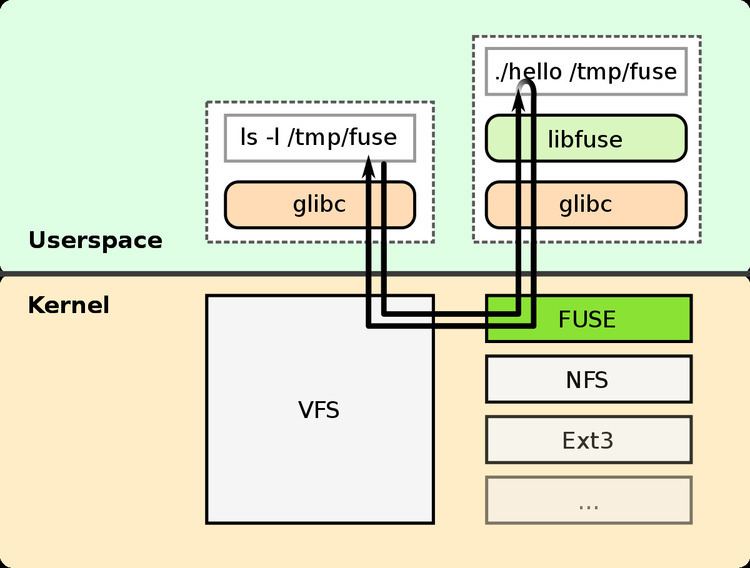Filesystem in Userspace (FUSE) is a software interface for Unix-like computer operating systems that lets non-privileged users create their own file systems without editing kernel code. This is achieved by running file system code in user space while the FUSE module provides only a "bridge" to the actual kernel interfaces.
FUSE is available for Linux, FreeBSD, OpenBSD, NetBSD (as puffs), OpenSolaris, Minix 3, Android and macOS.
FUSE is free software originally released under the terms of the GNU General Public License and the GNU Lesser General Public License.
The FUSE system was originally part of AVFS (A Virtual Filesystem), a filesystem implementation heavily influenced by the translator concept of the GNU Hurd.
FUSE was originally released under the terms of the GNU General Public License and the GNU Lesser General Public License, later also reimplemented as part of the FreeBSD base system and released under the terms of Simplified BSD license. An ISC-licensed re-implementation by Sylvestre Gallon was released in March 2013, and incorporated into OpenBSD in June 2013.
FUSE was officially merged into the mainstream Linux kernel tree in kernel version 2.6.14.
FUSE is particularly useful for writing virtual file systems. Unlike traditional file systems that essentially save data to, and retrieve data from, mass storage, virtual filesystems do not actually store data themselves. They act as a view or translation of an existing file system or storage device.
In principle, any resource available to a FUSE implementation can be exported as a file system.
archivemountCloudStore (formerly, Kosmos filesystem): By mounting via FUSE, existing Linux utilities can interface with CloudStoreEncFS: Encrypted virtual filesystemExpanDrive: A commercial filesystem implementing SFTP/FTP/S3/Swift using FUSEFTPFSGDFS: Filesystem which allows you to mount your Google Drive account on Linux.GlusterFS: Clustered Distributed Filesystem having ability to scale up to several petabytes.GmailFS: Filesystem which stores data as mail in GmailGVfs: The virtual filesystem for the GNOME desktopKBFS: A distributed filesystem with end-to-end encryption and a global namespace that uses FUSE to create cryptographically secure file mounts.Lustre cluster filesystem will use FUSE to allow it to run in userspace, so that a FreeBSD port is possible. However, the ZFS-Linux port of Lustre will be running ZFS's DMU (Data Management Unit) in userspace.MooseFS: An open source distributed fault-tolerant file system available on every OS with FUSE implementation (Linux, FreeBSD, NetBSD, OpenSolaris, OS X), able to store petabytes of data spread over several servers visible as one resource.NTFS-3G and Captive NTFS, allowing access to NTFS filesystemsSector File System: Sector is a distributed file system designed for large amount of commodity computers. Sector uses FUSE to provide a mountable local file system interfaceSSHFS: Provides access to a remote filesystem through SSHTransmit: A commercial FTP client that also adds the ability to mount WebDAV, SFTP, FTP and Amazon S3 servers as disks in Finder, via MacFUSE.WebDrive: A commercial filesystem implementing WebDAV, SFTP, FTP, FTPS and Amazon S3WikipediaFS: View and edit Wikipedia articles as if they were real filesWuala: A multi-platform, Java-based fully OS integrated distributed file system. Using FUSE, MacFUSE and Callback File System respectively for file system integration, in addition to a Java-based app accessible from any Java-enabled web browser.MinFS: MinFS is a fuse driver for Amazon S3 compatible object storage server. MinFS lets you mount a remote bucket (from a S3 compatible object store), as if it were a local directory
